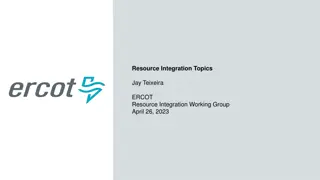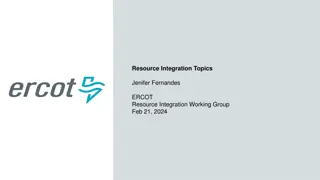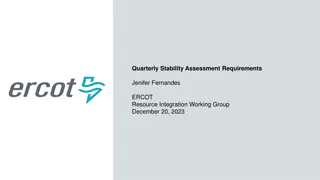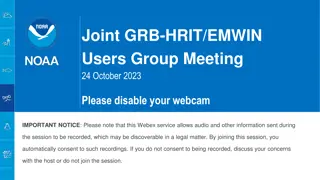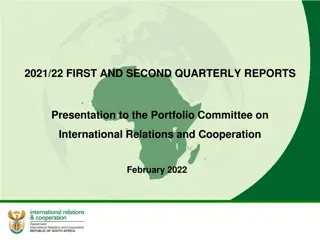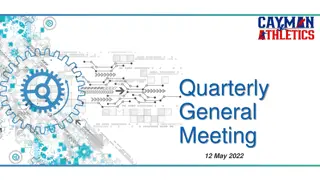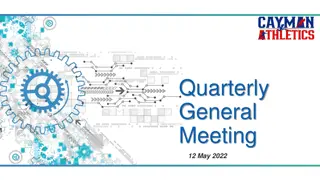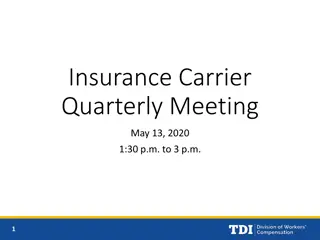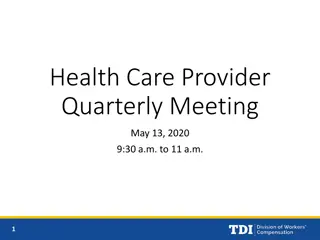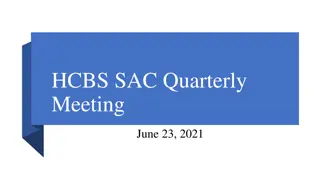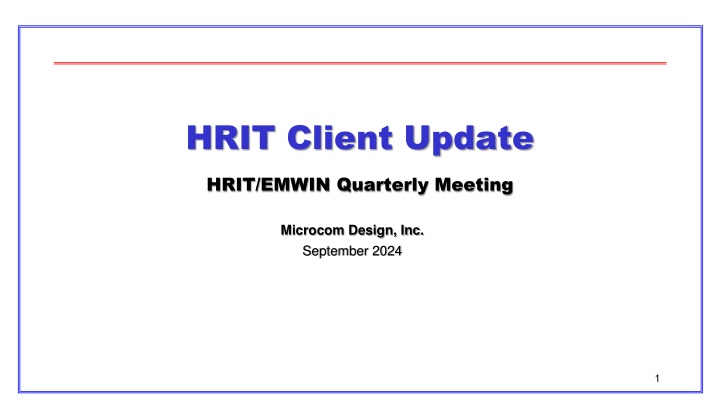
HRIT Client Update Quarterly Meeting Summary
"Stay informed about the latest updates from the HRIT/EMWIN Quarterly Meeting at Microcom Design, Inc. Discover the status of latency, data quality, retransmissions, SFTP connectivity, and more. Learn about issues with duplicate filenames and steps taken to resolve the connectivity problems. Follow the progress of updates and enhancements to address these challenges effectively." (326 characters)
Uploaded on | 1 Views
Download Presentation

Please find below an Image/Link to download the presentation.
The content on the website is provided AS IS for your information and personal use only. It may not be sold, licensed, or shared on other websites without obtaining consent from the author. If you encounter any issues during the download, it is possible that the publisher has removed the file from their server.
You are allowed to download the files provided on this website for personal or commercial use, subject to the condition that they are used lawfully. All files are the property of their respective owners.
The content on the website is provided AS IS for your information and personal use only. It may not be sold, licensed, or shared on other websites without obtaining consent from the author.
E N D
Presentation Transcript
HRIT Client Update HRIT/EMWIN Quarterly Meeting Microcom Design, Inc. September 2024 1
Agenda Overview Status Updates Latency Data Quality Monitor (DQM) Description Retransmissions Duplicate Filenames SFTP Connectivity Duplicate Filename Check Enhanced SFTP Connectivity Messages & Files Latency Chart CSV Export Microcom Design, Inc. 2
Status - Overview Following a hardware refresh of the DADDS system, PDA technicians began reporting duplicate filenames being received from the HRIT client. Approximately 10 files per day were quarantined by the PDA server. Investigation revealed that the server upgrade allowed multiple files to be created, send and removed in under 1 second, resulting in situations where duplicate filenames were used by the HRIT client. In addition, the SFTP link has experienced recurring connectivity issues that appear as upload timeout errors, followed by connect/disconnect cycles. Investigation showed connectivity problems are likely a result of the HRIT client having problems connecting after failover between OTT servers. Also showed the HRIT client reconnects following OTT server failover were failing due to differences between the connection being made by the client (SSH then SFTP) and the connection expected by the server (SFTP only) Microcom Design, Inc. 3
Status - Duplicate Filenames Updates to the HRIT client currently deployed ot the DADDS development system that connects to the PDA I&T server have reduced the number of duplicate filenames being received. Changes to the execution of the SFTP client state machine to slow down processing was the main driver of the improvement. Since then, the exact cause of the duplicate filenames was finally identified, and additional updates should completely resolve the issue. Test code added to the HRIT client confirm that tweaks to the duplicate filename checks handle the scenario that caused duplicate filenames. Additional updates tested internally at Microcom, and are waiting to be deployed to the development system real-time servers for final evaluation and testing. Test plan to evaluate the changes has been distributed to the DCS group for review, and will be used to confirm resolution of the duplicate filename issue. Microcom Design, Inc. 4
Status SFTP Connectivity While SFTP connectivity has been a recurrent issue for sometime, the link has been relatively stable in 2024. Attribute this to efforts of PDA engineers to improve connectivity on the server side of the link. Updates to the HRIT client have been made to mitigate connectivity problems. Deployed to the DADDS development system for evaluation and testing. Microcom Design, Inc. 5
Updates Duplicate Filename Check Prior to updates, the HRIT client performed a duplicate filename check on pending files in the upload directory. Unfortunately, this was not sufficient following server upgrades that improved performance, and allowed files to be created, sent and removed in under 1 second. To resolve the problem, the duplicate filename check was updated to track the last filename used by the client. Unfortunately this modification did not catch all instance of duplicate filenames. The final update to prevent all duplicate filenames modified the last filename check to use the file time only. If duplicate is detected the file time is incremented. A situation can occur where 3+ files are created in the same second. The 2nd filename has an instance char of, say B (due to the pending file check), but when a 3th file is created, the pending file has been sent, so the client uses an A char. Because the 3rd filename will not match the last filename so it passes the second duplicate filename check and the PDA will receive a file with the same name as the 1st file in the set. Microcom Design, Inc. 6
Updates Enhanced SFTP Connectivity Updates performed to improve SFTP connectivity. Keep Alive Timeout Enabled Increase SSH/SFTP timeouts Increase key re-exchange threshold Deployed to DADDS development system uploading DCS files to the PDA I&T server. Appears to result in more stable connections and reduce instances of upload timeouts leading to connect/disconnect cycles No further SFTP connectivity updates are expected at this time. Microcom Design, Inc. 7
Latency Messages & Files HRIT client has the ability to determine the message and file latencies. Performed as a running average over a set of latency values. Due to prior PDA latency issues it was never enabled but has been resolved for some time and can now be turned on. Message latency is determined by the date-time the message is stored by the HRIT receive process minus its end date-time Average message latency is 1024 value running average of individual message latencies, and averages 10s. File latency is determined by the date-time the file was completed minus the date-time the file was created. Average file latency is a 32 value running average of individual file latencies, and averages 12s. Microcom Design, Inc. 8
Latency Client Chart HRIT client contains a chart that displays average message and file latency for use by DCS operators. Microcom Design, Inc. 9
Latency CSV Export In addition to the latency chart, a CSV export of individual message latencies has been Implemented as a request by Ian A. File contains the platform address, HRIT filename, message end time, receive store date-time and the message latency in seconds Allows for offline analysis in Excel by PDA engineers that cannot be accomplished via the latency chart. Implemented as a debug feature that can be enabled and disabled as necessary. Not intended to be ran for extended periods of time due to build up of latency files. Microcom Design, Inc. 10
DQM - Description The Data Quality Monitor (DQM) component of the HRIT client is responsible for monitoring and comparing received and transmitted HRIT message data Also responsible for determining average message latency and retransmission of messages that have been sent to the PDA but are not included in received data. File latency is not determined by the DQM because it does not require receive data. Operates by iterating thru the list of sent messages, and querying the received message data for the message. Latency calculated for all messages returned by query. Can perform retransmission of missing messages. 4 Microcom Design, Inc. 11
DQM - Retransmissions DQM has the ability to identify messages that were sent to the PDA but not included in the received message data. A preference determines how long the DQM waits before declaring a message as being missing and rescheduling it for retransmission Messages declared as missing are inserted at the top of the pending message queue. Preference determines how many messages can be retransmitted (inserted) at once to prevent a flood of retransmissions in message data. Special message ARM code of R is assigned to retransmitted messages to prevent them from being retransmitted more than once. Flag in the HRIT message header byte flags messages as being retransmits to allow for identification upon being received. Microcom Design, Inc. 12
End of Presentation Questions / Comments? Microcom Design, Inc. 13




